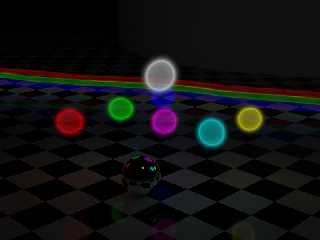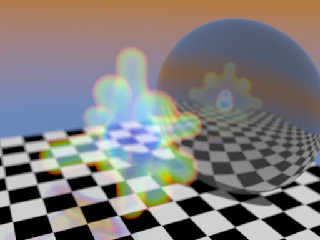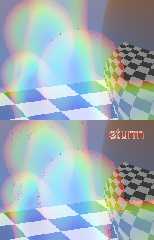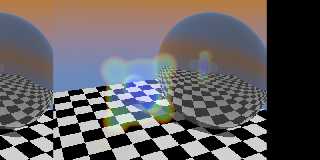 |
 |
|
 |
|
 |
|  |
|  |
|
 |
From: William F Pokorny
Subject: Example of potential pattern use with emitting media.
Date: 10 Oct 2016 20:39:56
Message: <57fc34dc@news.povray.org>
|
|
 |
|  |
|  |
|
 |
Experimenting with the new potential pattern and emitting media. In this
image both the media and container are blob based. The media uses the
3.7.1 potential pattern. Radiosity lighting only. Quite high AA to
address some speckles as rays just glance the surface of one or more
blob components.
Existing media boundary issues remain, requiring some care in set up.
The significant advantage of using blobs for both the density patterns
and the media container is performance(1). Given the radiosity and media
here, the final render is relatively fast at about 9 minutes on my two
core I3.
Frequency of the potential pattern set at 1.5 for the ring effect, plus
a little turbulence which can be seen most on the blob component cylinders.
Bill P.
(1) - As Jaime too showed with his cloud work some months back.
Post a reply to this message
Attachments:
Download 'potentialasglows.png' (323 KB)
Preview of image 'potentialasglows.png'

|
 |
|  |
|  |
|
 |
|
 |
|  |
|  |
|
 |
William F Pokorny <ano### [at] anonymous org> wrote:
> Experimenting with the new potential pattern and emitting media. In this
> image both the media and container are blob based.
>
> Existing media boundary issues remain, requiring some care in set up.
Tried it now too after seeing this.
Something going on at edges that I noticed during animation, maybe like you.
Only slightly visible as a tiny red curve along the surface near middle-right,
where the blob overlaps itself.
I didn't try 'frequency' yet.
This media uses mostly emission 0.4 and a little absorption 0.1, along with
scattering type 1, amount 0.6. Simple density_map of red green and blue, all
values of 1. org> wrote:
> Experimenting with the new potential pattern and emitting media. In this
> image both the media and container are blob based.
>
> Existing media boundary issues remain, requiring some care in set up.
Tried it now too after seeing this.
Something going on at edges that I noticed during animation, maybe like you.
Only slightly visible as a tiny red curve along the surface near middle-right,
where the blob overlaps itself.
I didn't try 'frequency' yet.
This media uses mostly emission 0.4 and a little absorption 0.1, along with
scattering type 1, amount 0.6. Simple density_map of red green and blue, all
values of 1.
Post a reply to this message
Attachments:
Download 'potentialpatternblobmediargb.jpg' (40 KB)
Preview of image 'potentialpatternblobmediargb.jpg'

|
 |
|  |
|  |
|
 |
From: William F Pokorny
Subject: Re: Example of potential pattern use with emitting media.
Date: 12 Oct 2016 03:45:38
Message: <57fdea22$1@news.povray.org>
|
|
 |
|  |
|  |
|
 |
On 10/11/2016 03:30 PM, omniverse wrote:
> William F Pokorny <ano### [at] anonymous org> wrote:
>> Experimenting with the new potential pattern and emitting media. In this
>> image both the media and container are blob based.
>>
>> Existing media boundary issues remain, requiring some care in set up.
>
> Tried it now too after seeing this.
> Something going on at edges that I noticed during animation, maybe like you.
> Only slightly visible as a tiny red curve along the surface near middle-right,
> where the blob overlaps itself.
> I didn't try 'frequency' yet.
>
> This media uses mostly emission 0.4 and a little absorption 0.1, along with
> scattering type 1, amount 0.6. Simple density_map of red green and blue, all
> values of 1.
>
I've never tried to use emitting with scattering. I do find myself using
absorption at a value about equal to the emission value to keep the
emitting media under some control where the ray path gets long in the
media - and so brighter. Such brightening is realistic for an emitting
media/gas to a point.
In an animation I suspect it is changing path length(s) through emitting
media that you are seeing more than blob container fringe, speckling,
effects. Especially as it looks to me like you are using some focal blur
which acts like strong AA with respect to all sorts of speckles and noise.
I went with multiple density based medias with set emission/absorption
colors which I then mixed at particular locations by using different
set-color blob components to get additional colors. In other words,
where white is seen there are really three overlapping medias of Red
Green and Blue. The containing blob for all the medias was constructed
to contain the blobs of each of the set-color medias.
Bill P. org> wrote:
>> Experimenting with the new potential pattern and emitting media. In this
>> image both the media and container are blob based.
>>
>> Existing media boundary issues remain, requiring some care in set up.
>
> Tried it now too after seeing this.
> Something going on at edges that I noticed during animation, maybe like you.
> Only slightly visible as a tiny red curve along the surface near middle-right,
> where the blob overlaps itself.
> I didn't try 'frequency' yet.
>
> This media uses mostly emission 0.4 and a little absorption 0.1, along with
> scattering type 1, amount 0.6. Simple density_map of red green and blue, all
> values of 1.
>
I've never tried to use emitting with scattering. I do find myself using
absorption at a value about equal to the emission value to keep the
emitting media under some control where the ray path gets long in the
media - and so brighter. Such brightening is realistic for an emitting
media/gas to a point.
In an animation I suspect it is changing path length(s) through emitting
media that you are seeing more than blob container fringe, speckling,
effects. Especially as it looks to me like you are using some focal blur
which acts like strong AA with respect to all sorts of speckles and noise.
I went with multiple density based medias with set emission/absorption
colors which I then mixed at particular locations by using different
set-color blob components to get additional colors. In other words,
where white is seen there are really three overlapping medias of Red
Green and Blue. The containing blob for all the medias was constructed
to contain the blobs of each of the set-color medias.
Bill P.
Post a reply to this message
|
 |
|  |
|  |
|
 |
|
 |
|  |
|  |
|
 |
William F Pokorny <ano### [at] anonymous org> wrote:
> In an animation I suspect it is changing path length(s) through emitting
> media that you are seeing more than blob container fringe, speckling,
> effects. Especially as it looks to me like you are using some focal blur
> which acts like strong AA with respect to all sorts of speckles and noise.
>
> I went with multiple density based medias with set emission/absorption
> colors which I then mixed at particular locations by using different
> set-color blob components to get additional colors. In other words,
> where white is seen there are really three overlapping medias of Red
> Green and Blue. The containing blob for all the medias was constructed
> to contain the blobs of each of the set-color medias.
I wouldn't have guessed right how you were doing that, thanks for explaining.
Occurred to me that I wasn't using the blob 'sturm' keyword and gave that a try,
not using AA or focal blur this time. Made matters worse, and I mean sturm did
not just removing the AA.
Closer look in images shown here. org> wrote:
> In an animation I suspect it is changing path length(s) through emitting
> media that you are seeing more than blob container fringe, speckling,
> effects. Especially as it looks to me like you are using some focal blur
> which acts like strong AA with respect to all sorts of speckles and noise.
>
> I went with multiple density based medias with set emission/absorption
> colors which I then mixed at particular locations by using different
> set-color blob components to get additional colors. In other words,
> where white is seen there are really three overlapping medias of Red
> Green and Blue. The containing blob for all the medias was constructed
> to contain the blobs of each of the set-color medias.
I wouldn't have guessed right how you were doing that, thanks for explaining.
Occurred to me that I wasn't using the blob 'sturm' keyword and gave that a try,
not using AA or focal blur this time. Made matters worse, and I mean sturm did
not just removing the AA.
Closer look in images shown here.
Post a reply to this message
Attachments:
Download 'potentialblobartifacts.png' (352 KB)
Preview of image 'potentialblobartifacts.png'

|
 |
|  |
|  |
|
 |
From: William F Pokorny
Subject: Re: Example of potential pattern use with emitting media.
Date: 13 Oct 2016 12:57:42
Message: <57ffbd06$1@news.povray.org>
|
|
 |
|  |
|  |
|
 |
On 10/12/2016 01:40 PM, omniverse wrote:
>
> I wouldn't have guessed right how you were doing that, thanks for explaining.
>
> Occurred to me that I wasn't using the blob 'sturm' keyword and gave that a try,
> not using AA or focal blur this time. Made matters worse, and I mean sturm did
> not just removing the AA.
> Closer look in images shown here.
>
Believe it or not, that sturm makes the fringe effect worse where blobs
are used as a media container is a known issue. I avoided sturm knowing
this.
I also cheated a little on my overall blob container making the
containing blob slightly larger than the set-union of all the blob
components making up the blob-color medias. This can often be done with
the threshold alone by making the containing blob threshold a tiny bit
smaller, such as the threshold minus 1e-4 or 1e-5. For my image I used
turbulence and so needed to make the radius on my containing cylinders a
little larger still by simply increasing the radius. Increasing the
containing blob component radius upward is naturally another way to up
the size of the containing blob.
Making the container a little larger doesn't eliminate the bad fringe
media intervals, but rather it tends to move them outward to where there
is a density of 0 - often helping with bright speckles at least.
As for the media fringe speckles themselves, I have the thought perhaps
we could test media intervals for sanity. Is the mid-point of the range
inside the container; Are points just a little beyond the two end points
both testing as outside the container; ahead of sampling and calculation.
I've never examined the media code - so this ray interval sanity test
thought is perhaps crazy. Such testing would certainly degrade
performance for media itself, but, we are today adding run time outside
by other means to address the fringe effects.
Mixed in this too is my softly proposed (I've not yet made it a pull
request) blob code tuning from early this year. A branch with my current
tuning value change is at:
https://github.com/wfpokorny/povray/tree/tune/blob_accuracy
The potential pattern is brand new. I am learning about its behavior
too. Lots I haven't tried about which I wonder. Negative blobs;
Semi-transparent containers textured via the uniquely flexible
negative/positive blob component methods. With isosurface based
potentials we can of course manipulate the container and media together.
What about blob based potential patterns as functions defining
isosurfaces.
Lastly, could I please get a copy of your last scene to add to my blob
artifact cases? It happens to be somewhat unique to those I have in my
collection in having lots of both bright and dark speckles.
Bill P.
Post a reply to this message
|
 |
|  |
|  |
|
 |
|
 |
|  |
|  |
|
 |
William F Pokorny <ano### [at] anonymous org> wrote:
> On 10/12/2016 01:40 PM, omniverse wrote:
> >
> > I wouldn't have guessed right how you were doing that, thanks for explaining.
--->8---8<---
> Making the container a little larger doesn't eliminate the bad fringe
> media intervals, but rather it tends to move them outward to where there
> is a density of 0 - often helping with bright speckles at least.
--->8---8<---
> As for the media fringe speckles themselves, I have the thought perhaps
> we could test media intervals for sanity. Is the mid-point of the range
> inside the container; Are points just a little beyond the two end points
> both testing as outside the container; ahead of sampling and calculation.
>
> Lastly, could I please get a copy of your last scene to add to my blob
> artifact cases?
Sure thing, I will just go ahead and put the fairly short SDL (yet too long to
post here probably) at the scene file text group. You will no doubt need to zoom
the camera for closer looks, or render very large images!
I had no idea sturm was a known cause of semi-transparent blobs. Hope to see
your change idea get added. Thanks!
Bob org> wrote:
> On 10/12/2016 01:40 PM, omniverse wrote:
> >
> > I wouldn't have guessed right how you were doing that, thanks for explaining.
--->8---8<---
> Making the container a little larger doesn't eliminate the bad fringe
> media intervals, but rather it tends to move them outward to where there
> is a density of 0 - often helping with bright speckles at least.
--->8---8<---
> As for the media fringe speckles themselves, I have the thought perhaps
> we could test media intervals for sanity. Is the mid-point of the range
> inside the container; Are points just a little beyond the two end points
> both testing as outside the container; ahead of sampling and calculation.
>
> Lastly, could I please get a copy of your last scene to add to my blob
> artifact cases?
Sure thing, I will just go ahead and put the fairly short SDL (yet too long to
post here probably) at the scene file text group. You will no doubt need to zoom
the camera for closer looks, or render very large images!
I had no idea sturm was a known cause of semi-transparent blobs. Hope to see
your change idea get added. Thanks!
Bob
Post a reply to this message
|
 |
|  |
|  |
|
 |
|
 |
|  |
|  |
|
 |
William F Pokorny <ano### [at] anonymous org>
> (1) - As Jaime too showed with his cloud work some months back.
>
Those orbs are cool. I quite like them, they remind me of dyed cells a bit.
Ian org>
> (1) - As Jaime too showed with his cloud work some months back.
>
Those orbs are cool. I quite like them, they remind me of dyed cells a bit.
Ian
Post a reply to this message
|
 |
|  |
|  |
|
 |
From: William F Pokorny
Subject: Re: Example of potential pattern use with emitting media.
Date: 18 Nov 2016 05:59:11
Message: <582edeff$1@news.povray.org>
|
|
 |
|  |
|  |
|
 |
On 11/17/2016 10:03 PM, [GDS|Entropy] wrote:
> William F Pokorny <ano### [at] anonymous org>
>> (1) - As Jaime too showed with his cloud work some months back.
>>
>
> Those orbs are cool. I quite like them, they remind me of dyed cells a bit.
>
> Ian
>
Thanks Ian.
Bill P. org>
>> (1) - As Jaime too showed with his cloud work some months back.
>>
>
> Those orbs are cool. I quite like them, they remind me of dyed cells a bit.
>
> Ian
>
Thanks Ian.
Bill P.
Post a reply to this message
|
 |
|  |
|  |
|
 |
From: William F Pokorny
Subject: Re: Example of potential pattern use with emitting media.
Date: 20 Mar 2019 14:15:19
Message: <5c928337$1@news.povray.org>
|
|
 |
|  |
|  |
|
 |
On 10/13/16 4:27 PM, omniverse wrote:
> William F Pokorny <ano### [at] anonymous org> wrote:
...
>> Lastly, could I please get a copy of your last scene to add to my blob
>> artifact cases?
>
> Sure thing, I will just go ahead and put the fairly short SDL (yet too long to
> post here probably) at the scene file text group. You will no doubt need to zoom
> the camera for closer looks, or render very large images!
>
> I had no idea sturm was a known cause of semi-transparent blobs. Hope to see
> your change idea get added. Thanks!
>
> Bob
>
Happened to be looking through old blob test cases and saw yours and
thought I'd follow up not realizing your post was back in October
2016..! Solver stuff turns out to be hard and I'm still working through
issues, but for the record the updated branch at:
https://github.com/wfpokorny/povray/tree/fix/polynomialsolverAccuracy
handles your psoted scene well now with or without sturm. See attached,
sturm on, image of current v38 at commit 74b3ebe and the update solver
branch as of today.
Bill P. org> wrote:
...
>> Lastly, could I please get a copy of your last scene to add to my blob
>> artifact cases?
>
> Sure thing, I will just go ahead and put the fairly short SDL (yet too long to
> post here probably) at the scene file text group. You will no doubt need to zoom
> the camera for closer looks, or render very large images!
>
> I had no idea sturm was a known cause of semi-transparent blobs. Hope to see
> your change idea get added. Thanks!
>
> Bob
>
Happened to be looking through old blob test cases and saw yours and
thought I'd follow up not realizing your post was back in October
2016..! Solver stuff turns out to be hard and I'm still working through
issues, but for the record the updated branch at:
https://github.com/wfpokorny/povray/tree/fix/polynomialsolverAccuracy
handles your psoted scene well now with or without sturm. See attached,
sturm on, image of current v38 at commit 74b3ebe and the update solver
branch as of today.
Bill P.
Post a reply to this message
Attachments:
Download 'oma_to_omb.png' (269 KB)
Preview of image 'oma_to_omb.png'

|
 |
|  |
|  |
|
 |
|
 |
|  |




![]()